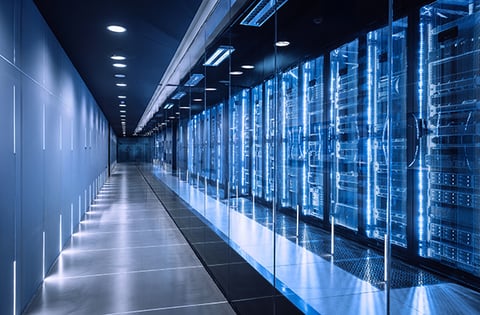
As data centers race to support higher computing loads, traditional air cooling methods are reaching their limits. Liquid cooling has emerged as a game-changing solution, with direct-to-chip and immersion cooling technologies leading the way.
Direct-to-Chip Cooling
In the shift toward liquid cooling, one technology that is gaining traction is direct-to-chip cooling. Also called cold-plate cooling, this system circulates coolant through cold plates that come into contact with the computer processing units (CPU) and graphics processing units (GPU). In a single-phase DTC system, the coolant remains in liquid form as it absorbs heat from the hot components, while in a two-phase system the fluid boils, vaporizes, and then condenses.
DTC cooling offers numerous advantages, including low thermal resistance as it cools the heat at the source—the chip—and requires less coolant than immersion cooling. Its system components are easily accessible for maintenance, and it can be scaled and integrated into an existing data center with ease.
Conversely, while DTC cooling is effective, only the areas in direct contact with cold plates are cooled, which can lead to hot spots and a dependence on air cooling infrastructure. In addition, the coolant is transferred through a complex network of tubing and pumps, increasing the risk of leaks and failures.
Immersion Cooling
Another emerging method of liquid cooling is immersion cooling. In this system, IT equipment is fully submerged in a non-conductive liquid. The coolant absorbs the heat and carries it away. Immersion cooling can be a single-phase system, where the coolant circulates through a heat exchanger and remains a liquid throughout the process, or a two-phase system where the coolant changes phases as it boils and vaporizes to form a closed loop.
Immersion cooling offers the advantage of uniform cooling across the system without the need for air cooling. This reduces the amount of cooling infrastructure needed and helps reduce the overall noise in the data center.
However, immersion cooling has a high initial cost, especially when retrofitting an existing data center, due to the need for tanks, dielectric fluids, structural supports for heavy baths, and careful plumbing. In addition, fluid management in immersion cooling can be expensive, and the long-term stability and compatibility with materials should be confirmed. Maintenance is also challenging, as all of the components have to be removed from the liquid.
Key Considerations
The age of liquid cooling in data centers has arrived, but the debate on the best cooling method is still underway. Direct-to-chip cooling excels in smaller, modular setups and integrates more easily into existing air-cooled facilities. While DTC can be a more cost-effective entry point with potentially lower installation and maintenance costs for targeted applications, it also carries a higher risk of disruptive leaks. Immersion cooling, on the other hand, significantly boosts server density and energy efficiency but requires substantial infrastructure investment, strict fluid safety protocols, and often custom designs.
Dixon Products for Data Center Cooling
Dixon offers superior thermal management solutions for data centers, enhancing heat dissipation and system performance. Leveraging expert engineering, we can provide customized solutions to ensure optimal efficiency and reliability. Key product offerings include:
- Combination nipples
- Coolant quick disconnects
- Sanitary valves
- Clamps
- Other related products
As a contributor to the Open Compute Project, Dixon is actively engaged in developing innovative components for data center cooling systems. Whether it’s solving a misalignment issue to prevent leaking, improving a product currently on the market, or developing something new, our experienced engineering team is ready to take on the challenge.
Summary
Both direct-to-chip and immersion cooling represent powerful advances in data center thermal management, each offering unique benefits depending on infrastructure, workload, and strategic goals. As data demands continue to surge, understanding these two methods is essential for making informed, forward-thinking decisions. Whether optimizing for performance, sustainability, or cost, choosing the right liquid cooling strategy can significantly impact the long-term success of data center operations.
For more information, visit dixonvalve.com or call 877.963.4966.



